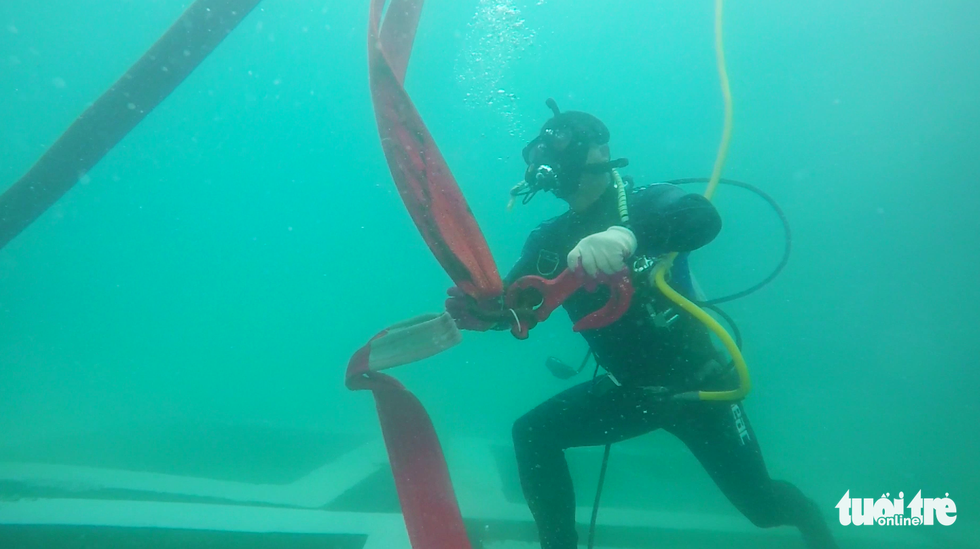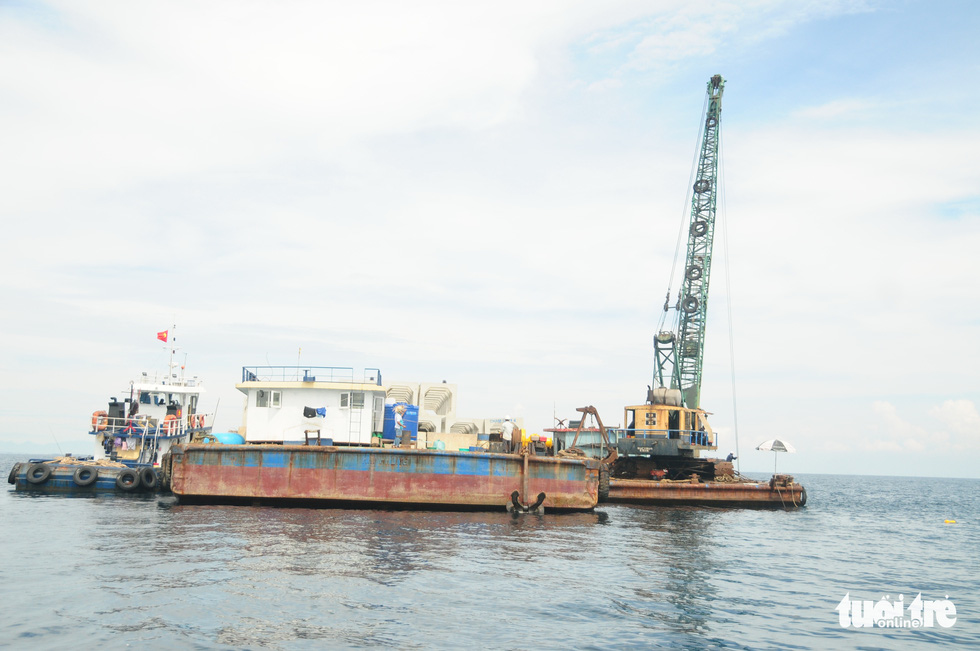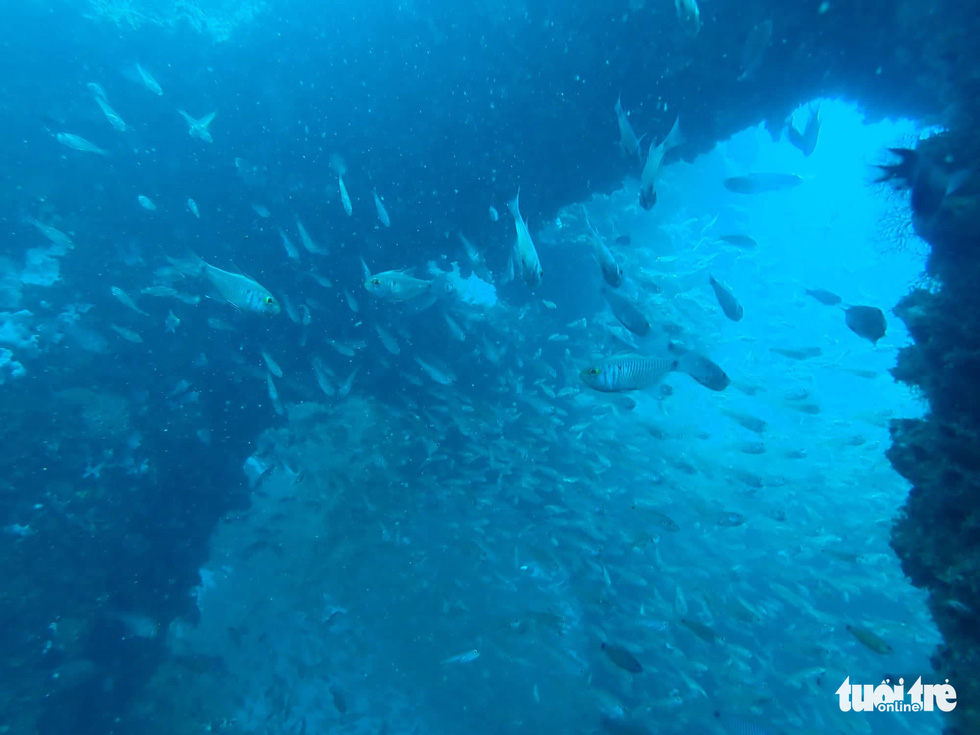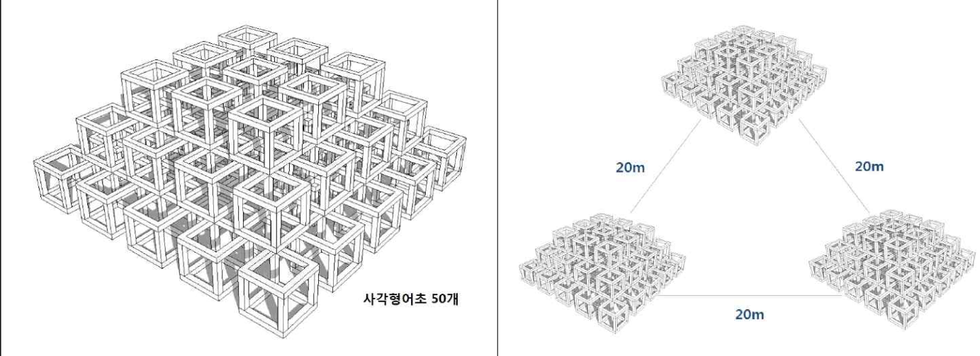In Cu Lao Cham (Cham Island) in Quang Nam Province, central Vietnam, shoals of fish and shrimp have been gifted with new safe man-made shelter and a huge incubator at the bottom of the ocean.
One day in mid-July, a large barge carrying a crane truck and big square-shaped concrete blocks docked at Cu Lao Cham.
These blocks were soaked in the deep sea to create a house for fish and shrimp.
Home built in deep sea
South Korea’s Sea Morning Company is the investor of a project to build a home for fish at the bottom of the sea, 20-25 meters deep.
Choi Sang Hack, a South Korean expert, was motioning for the crane operator to drop the blocks into the sea.
“Turn left! Turn right! A little bit closer. Okay, drop it down,” he shouted, while holding a smartphone that served his task.
At around 11:00 am, half of the concrete blocks were removed from the barge.
Pointing at his underwater camera, Choi said, “This camera films the job of dropping concrete blocks into the sea and recording images of underwater operations.”
|
|
| A picture shows a barge carrying a crane truck and concrete blocks to the working site in Cu Lao Cham, Quang Nam Province, central Vietnam. Photo: Tuoi Tre |
The camera also stores the images of the stunning undersea world in the Cu Lao Cham Biosphere Reserve.
Moreover, it caught the moments of frogmen steering these concrete blocks toward the right location.
Hard-working underwater jobs
It was not until the final concrete blocks were dropped into the deep ocean that Cho used a special-use device to contact these frogmen in the depth of 25 meters and asked them to take a rest.
After that, two frogmen, Kim Sang Bom and Kim Ky Young, came to the surface of the water gasping for air.
Bom and Young are two of the most skilled frogmen in the group at Sea Morning Company, which is in charge of the project of creating artificial reefs for fish and shrimp, said engineer Nguyen Van Vu, deputy head of the management board of the Cham Island Marine Protected Area.
The group of frogmen has worked on many projects in Vietnam, Bom said, adding that they have been building artificial reefs in the waters off Cham Island since 2021.
To work underwater, these workers must wear a rubber suit, flippers and an oxygen tank, and wrap lead wire around their body.
When concrete blocks are dropped into the water, these frogmen cling to the blocks and position them.
“Due to diving and working in the high-pressure deep-sea environment for hours, we often spend much time resting and recovering after work,” Bom said.
|
|
| A South Korea expert motions workers to drop a concrete block into the deep sea to form reefs for fish and shrimp in Cu Lao Cham, Quang Nam Province, central Vietnam. Photo: B.D. / Tuoi Tre |
Speaking of the location selected to build the house for fish in Cu Lao Cham, engineer Vu said that despite being a small island, Cu Lao Cham is closely followed by people around the world due to not only its ecosystem but also its importance for aquatic resources.
During the seabed exploration and monitoring process, experts found surrounding Cu Lao Cham are multiple natural reefs which are home to fish and shrimp.
In their breeding season, fish and shrimp use the reefs as a safe haven to lay eggs.
However, fishing has caused inevitable wear and tear on such reefs.
As such, the South Korea Fisheries Resources Agency (FIRA) decided to select Manh Reef in the water off Cham Island to execute a project to develop artificial reefs, which are built with concrete blocks.
Before the launch of the project, experts at the Cu Lao Cham Biosphere Reserve and South Korean frogmen went scuba diving to locations around the island to survey and map out a detailed plan.
|
|
| Fish live in the man-made reefs, which are their concrete home. Photo: B.D. / Tuoi Tre |
“We decided to choose Manh Reef, four kilometers from the center of the island, to build the home for fish and shrimp, as the place has a huge reef, a stable seabed, a smooth flow, and perfect natural features," said Vu.
"Dropping blocks will widen the house for fish and shrimp,”
600 concrete blocks
The project sponsored by FIRA, with a value of around VND8.5 billion (US$362.2 million), was kick-started in 2020.
The project has been resumed after a long pause because of the COVID-19 pandemic.
The man-made reefs comprising a total of 600 concrete blocks are situated at four locations surrounding a big natural reef.
Each artificial reef is shaped into a tower by 150 blocks.
After being completed, the project will be handed over to Quang Nam authorities.
Like us on Facebook or follow us on Twitter to get the latest news about Vietnam!























































